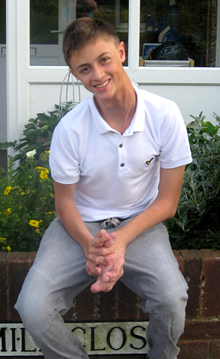Gene Defect Linked to Disfiguring Disorder
Gene Defect Linked to Disfiguring Disorder
Scientists have identified the faulty gene responsible for Proteus syndrome, a rare disorder marked by uncontrolled growth of certain body tissues and organs. The finding could have implications for developing targeted therapies for the condition. It may also offer insights into cancer progression and treatment.

- Jordan, 16, from Bexhill, UK, has Proteus syndrome, an extremely rare overgrowth disorder that affects his fingers, spine and neck. At 14, he elected to undergo above-the-knee amputations of his legs, which had become severely affected by the condition, and now walks with prosthetic legs. Courtesy of the Proteus Syndrome Foundation UK.
Named for a shape-shifting god from Greek mythology, Proteus syndrome affects fewer than 500 people in the developed world. Some body parts grow massively out of proportion, while other regions are unaffected. The sporadic overgrowth can affect nearly any tissue in the body. Its most famous victim may be 19th century Londoner John Merrick, also known as the “Elephant Man,” although his diagnosis has not been confirmed.
Proteus syndrome does not run in families, but faulty genes were believed to be responsible. Some experts proposed that the condition might be a genetic mosaicism. Mosaic disorders arise when a genetic mutation occurs spontaneously during embryonic development. All descendents of the cell with the mutation would then also carry the mutation, while other dividing cells remain unaffected. As a result, the disease-causing mutation would be found in only a subset of the body’s cells.
To test the mosaic hypothesis for Proteus syndrome, a research team led by scientists at NIH’s National Human Genome Research Institute (NHGRI) used whole-exome sequencing. This relatively new technique focuses on sequencing DNA’s protein-coding regions, or exons, which make up about 1.5% of the genome. The study was described in the July 27, 2011, early online edition of the New England Journal of Medicine.
The researchers analyzed the exomes of both normal and affected cells from 6 patients with Proteus syndrome, as well as family members. The analysis revealed a single-letter misspelling in the genome of affected cells. The mutated gene, called AKT1, is a known oncogene—a gene that can promote the uncontrolled cell growth associated with cancer. In fact, several potential cancer therapies are now being developed to inhibit the pathway involving this gene.
To confirm the link to Proteus syndrome, the scientists searched for the mutation in additional patients with the disorder. The suspect variant was found in 26 of the 29 people tested. By contrast, the variant was never found in unaffected people, including thousands of DNA sequences maintained in public genome research databases.
To study the functional effect of the mutation, the researchers analyzed the activation of the AKT protein in both affected and unaffected tissues from the patients. The analysis confirmed that affected tissue had increased AKT protein activity. The mutation thus acts like an accelerator of cell growth.
“We now have a better chance of making or finding a drug that can arrest this overgrowth and begin to use it early on in the disease progression,” says senior author Dr. Leslie Biesecker of NHGRI. “A factor in our favor is that it is much easier to find a drug that inhibits the activity of a protein, which is what we want to do with AKT in Proteus syndrome, than to activate a protein.”
* The above story is reprinted from materials provided by National Institutes of Health (NIH)
** The National Institutes of Health (NIH) , a part of the U.S. Department of Health and Human Services, is the nation’s medical research agency—making important discoveries that improve health and save lives. The National Institutes of Health is made up of 27 different components called Institutes and Centers. Each has its own specific research agenda. All but three of these components receive their funding directly from Congress, and administrate their own budgets.


















